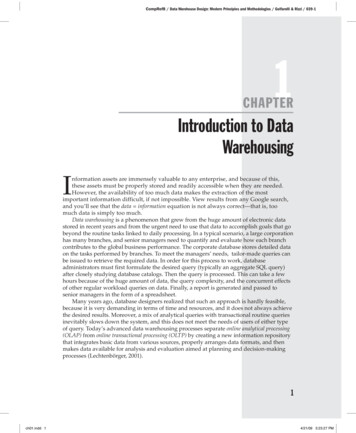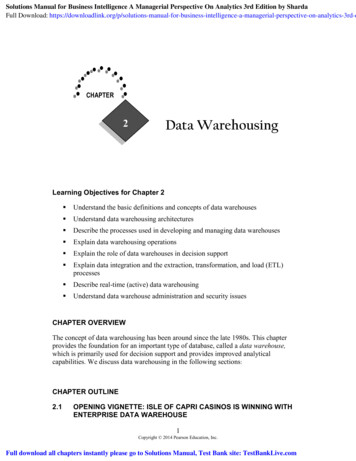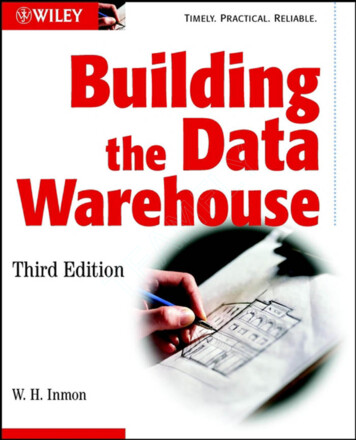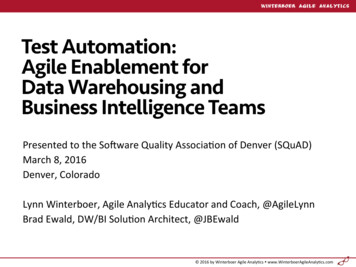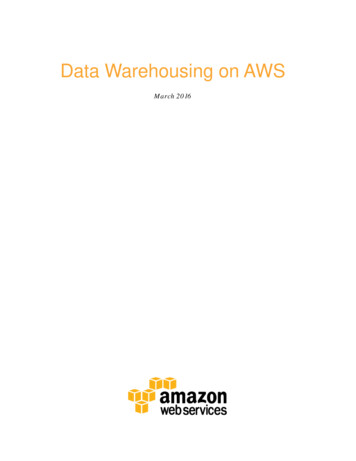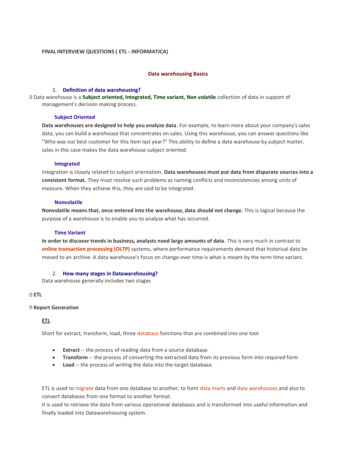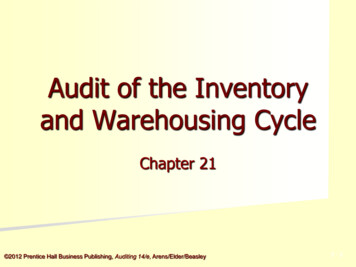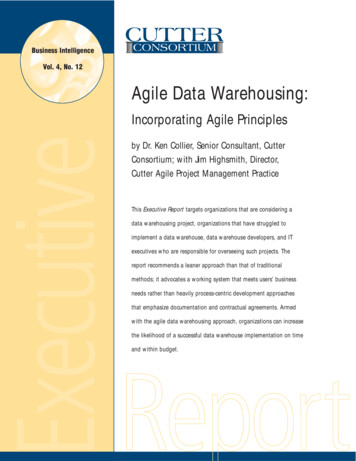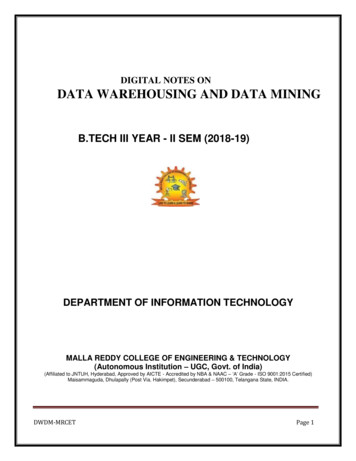
Transcription
DIGITAL NOTES ONDATA WAREHOUSING AND DATA MININGB.TECH III YEAR - II SEM (2018-19)DEPARTMENT OF INFORMATION TECHNOLOGYMALLA REDDY COLLEGE OF ENGINEERING & TECHNOLOGY(Autonomous Institution – UGC, Govt. of India)(Affiliated to JNTUH, Hyderabad, Approved by AICTE - Accredited by NBA & NAAC – ‘A’ Grade - ISO 9001:2015 Certified)Maisammaguda, Dhulapally (Post Via. Hakimpet), Secunderabad – 500100, Telangana State, INDIA.DWDM-MRCETPage 1
MALLA REDDY COLLEGE OF ENGINEERING & TECHNOLOGYDEPARTMENT OF INFORMATION TECHNOLOGYIII Year B. Tech. IT –II SemL5T/P/D C-/- / - 4(R15A0526) DATA WAREHOUSING AND DATA MININGObjectives:Understand the fundamental processes, concepts and techniques of data mining and develop anappreciation for the inherent complexity of the data-mining task.Characterize the kinds of patterns that can be discovered by association rule mining.Evaluate methodological issues underlying the effective application of data mining.Advance research skills through the investigation of data-mining literature.UNIT IData Warehouse: Introduction to data Warehouse,Difference between operational databasesystems and data warehouses,Data Warehouse Characateristics, Data Warehouse Architectureand its components, Extraction-Transformation-Loading, Logical(Multi-Dimensional), DataModeling,Schema Design, Star and Snow-Flake Schema,fact Constellation, Fact Table, FullyAdditive, Semi Additive, Non Additive Measures; Fact-less Facts, Dimension TableCharacteristics,OLAP Cube, OLAP Operations,OLAP Server Architecture-ROLAP,MOLAP andHOLAP.UNIT IIIntroduction: Fundamentals of data mining, Data Mining Functionalities, Classification of DataMining systems, Data Mining Task Primitives, Integration of a Data Mining System with aDatabase or a Data Warehouse System, Major issues in Data Mining.Data Preprocessing: Need for Preprocessing the Data, Data Cleaning, Data Integration andTransformation, Data Reduction, Discretization and Concept Hierarchy Generation.UNIT-IIIDWDM-MRCETPage 2
Association Rules: Problem Definition, Frequent Item Set Generation, The APRIORI Principle,Support and Confidence Measures, Association Rule Generation; APRIOIRI Algorithm, ThePartition Algorithms, FP-Growth Algorithms, Compact Representation of Frequent Item SetMaximal Frequent Item Set, Closed Frequent Item Set.UNIT IVClassification: Problem Definition, General Approaches to solving a classification problem,Evaluation of Classifiers , Classification techniques, Decision Trees-Decision tree Construction,Methods for Expressing attribute test conditions, Measures for Selecting the Best Split,Algorithm for Decision tree Induction ; Naive-Bayes Classifier, Bayesian Belief Networks; KNearest neighbor classification-Algorithm and Characteristics. Prediction: Accuracy and Errormeasures. Evaluating the accuracy of a Classifier or a Predictor, Ensemble MethodsUNIT VCluster Analysis : Types of Data in Cluster Analysis, A Categorization of Major ClusteringMethods, Partitioning Methods, Hierarchical Methods, Density-Based Methods, Grid-BasedMethods, Model-Based Clustering Methods, Outlier AnalysisTEXT BOOKS:1. Data Mining-Concepts and Techniques -Jiawei Han & Michel Kamber. Morten Publisher 2ndEdition, 2006.REFERENCE BOOKS:Data Mining Introductory and advanced topics -Margaret H Dunham. Pearson education.Data Mining Techniques - Arun K Pujari. University Press.Data Warehousing in the Real World- Sam Aanhory & Dennis Murray Pearson in Edn Asia. .Data Warehousing Fundamentals-Paulraj Ponnaiah Wiley student EditionThe Data Warehouse Life cycle Tool kit-Ralph Kimball Wiley student editionOutcomes:At the end of this course the student should be able toAcquire knowledge about different data mining models and techniques.Explore various Data mining and data warehousing application areas.Demonstrate an appreciation of the importance of paradigms from the fields of ArtificialIntelligence and Machine Learning to data mining.DWDM-MRCETPage 3
MALLA REDDY COLLEGE OF ENGINEERING & TECHNOLOGYDEPARTMENT OF INFORMATION TECHNOLOGYINDEXS. NoUnitTopicPage no1IIntroduction to Knowledge Discovery in Databases(KDD)52IA Three Tier Data Warehouse Architecture93IDataWare House Models114IIIntroduction to Data Mining165IIArchitecture Data Mining186IIClassification Data Mining237IIMajor Issues of Data mining258IIIAssociation Rules Mining309IIIEfficient Frequent Itemset Mining Methods3610IIIApproaches For Mining Multilevel Associations4211IVClassification and Prediction4612IVClassification by Decision Tree4913IVBayesian Classification5214IVK-Nearest Neighbor Calssifier5915VCluster Analysis6616VClassical Partitioning Methods7217VOutlier Analysis79DWDM-MRCETPage 4
MALLA REDDY COLLEGE OF ENGINEERING & TECHNOLOGYDEPARTMENT OF INFORMATION TECHNOLOGYUNIT-IKnowledge Discovery in Databases(KDD)Some people treat data mining same as Knowledge discovery while some people view datamining essential step in process of knowledge discovery. Here is the list of steps involved inknowledge discovery process:Data Cleaning - In this step the noise and inconsistent data is removed.Data Integration - In this step multiple data sources are combined.Data Selection - In this step relevant to the analysis task are retrieved from the database.Data Transformation - In this step data are transformed or consolidated into formsappropriate for mining by performing summary or aggregation operations.Data Mining - In this step intelligent methods are applied in order to extract datapatterns.Pattern Evaluation - In this step, data patterns are evaluated.Knowledge Presentation - In this step,knowledge is represented.DWDM-MRCETPage 5
The following diagram shows the process of knowledge discovery process:Architecture of KDDData Warehouse:A data warehouse is a subject-oriented, integrated, time-variant and non-volatile collection ofdata in support of management's decision making process.DWDM-MRCETPage 6
Subject-Oriented: A data warehouse can be used to analyze a particular subject area. Forexample, "sales" can be a particular subject.Integrated: A data warehouse integrates data from multiple data sources. For example, source Aand source B may have different ways of identifying a product, but in a data warehouse, therewill be only a single way of identifying a product.Time-Variant: Historical data is kept in a data warehouse. For example, one can retrieve datafrom 3 months, 6 months, 12 months, or even older data from a data warehouse. This contrastswith a transactions system, where often only the most recent data is kept. For example, atransaction system may hold the most recent address of a customer, where a data warehouse canhold all addresses associated with a customer.Non-volatile: Once data is in the data warehouse, it will not change. So, historical data in a datawarehouse should never be altered.Data Warehouse Design Process:A data warehouse can be built using a top-down approach, a bottom-up approach, or acombination of both.The top-down approach starts with the overall design and planning. It is useful in caseswhere the technology is mature and well known, and where the business problems that mustbe solved are clear and well understood.The bottom-up approach starts with experiments and prototypes. This is useful in the earlystage of business modeling and technology development. It allows an organization to moveforward at considerably less expense and to evaluate the benefits of the technology beforemaking significant commitments.In the combined approach, an organization can exploit the planned and strategic nature ofthe top-down approach while retaining the rapid implementation and opportunisticapplication of the bottom-up approach.DWDM-MRCETPage 7
The warehouse design process consists of the following steps:Choose a business process to model, for example, orders, invoices, shipments, inventory,account administration, sales, or the general ledger. If the business process is organizationaland involves multiple complex object collections, a data warehouse model should befollowed. However, if the process is departmental and focuses on the analysis of one kind ofbusiness process, a data mart model should be chosen.Choose the grain of the business process. The grain is the fundamental, atomic level of datato be represented in the fact table for this process, for example, individual transactions,individual daily snapshots, and so on.Choose the dimensions that will apply to each fact table record. Typical dimensions aretime, item, customer, supplier, warehouse, transaction type, and status.Choose the measures that will populate each fact table record. Typical measures are numericadditive quantities like dollars sold and units sold.DWDM-MRCETPage 8
A Three Tier Data Warehouse Architecture:Tier-1:The bottom tier is a warehouse database server that is almost always a relationaldatabasesystem. Back-end tools and utilities are used to feed data into the bottomtier fromoperational databases or other external sources (such as customer profileinformationprovided by external consultants). These tools and utilities performdataextraction,cleaning, and transformation (e.g., to merge similar data from differentsources into aunified format), as well as load and refresh functions to update thedata warehouse . Thedata are extracted using application programinterfaces known as gateways. A gateway isDWDM-MRCETPage 9
supported by the underlying DBMS andallows client programs to generate SQL code tobe executed at a server.Examplesof gateways include ODBC (Open Database Connection) and OLEDB (OpenLinkingand Embedding for Databases) by Microsoft and JDBC (Java DatabaseConnection).This tier also contains a metadata repository, which stores information aboutthe datawarehouse and its contents.Tier-2:The middle tier is an OLAP server that is typically implemented using either a relationalOLAP (ROLAP) model or a multidimensional OLAP.OLAP model is an extended relational DBMS thatmaps operations on multidimensionaldata to standard relational operations.A multidimensional OLAP (MOLAP) model, that is, a special-purpose server thatdirectly implements multidimensional data and operations.Tier-3:The top tier is a front-end client layer, which contains query and reporting tools,analysis tools, and/or data mining tools (e.g., trend analysis, prediction, and so on).DWDM-MRCETPage 10
Data Warehouse Models:There are three data warehouse models.1. Enterprise warehouse:An enterprise warehouse collects all of the information about subjects spanning the entireorganization.It provides corporate-wide data integration, usually from one or more operational systemsor external information providers, and is cross-functional in scope.It typically contains detailed data aswell as summarized data, and can range in size from afew gigabytes to hundreds of gigabytes, terabytes, or beyond.An enterprise data warehouse may be implemented on traditional mainframes, computersuperservers, or parallel architecture platforms. It requires extensive business modelingand may take years to design and build.2.Data mart:A data mart contains a subset of corporate-wide data that is of value to aspecific group ofusers. The scope is confined to specific selected subjects. For example,a marketing datamart may confine its subjects to customer, item, and sales. Thedata contained in datamarts tend to be summarized.Data marts are usually implemented on low-cost departmental servers thatareUNIX/LINUX- or Windows-based. The implementation cycle of a data mart ismorelikely to be measured in weeks rather than months or years. However, itmay involvecomplex integration in the long run if its design and planning werenot enterprise-wide.DWDM-MRCETPage 11
Depending on the source of data, data marts can be categorized as independentordependent. Independent data marts are sourced fromdata captured fromone ormoreoperational systems or external information providers, or fromdata generatedlocallywithin a particular department or geographic area. Dependent data marts aresourceddirectly from enterprise data warehouses.3. Virtual warehouse:A virtual warehouse is a set of views over operational databases. Forefficient queryprocessing, only some of the possible summary views may be materialized.A virtual warehouse is easy to build but requires excess capacity on operational databaseservers.Meta Data Repository:Metadata are data about data.When used in a data warehouse, metadata are the data thatdefinewarehouse objects. Metadata are created for the data names anddefinitions of the givenwarehouse. Additional metadata are created and captured fortimestamping any extracted data,the source of the extracted data, and missing fieldsthat have been added by data cleaning orintegration processes.A metadata repository should contain the following:A description of the structure of the data warehouse, which includes the warehouseschema, view, dimensions, hierarchies, and derived data definitions, as well as data martlocations and contents.Operational metadata, which include data lineage (history of migrated data and thesequence of transformations applied to it), currency of data (active, archived, or purged),and monitoring information (warehouse usage statistics, error reports, and audit trails).DWDM-MRCETPage 12
The algorithms used for summarization, which include measure and dimensiondefinitionalgorithms, data on granularity, partitions, subject areas, aggregation,summarization,and predefined queries and reports.The mapping from the operational environment to the data warehouse, whichincludessource databases and their contents, gateway descriptions, data partitions, dataextraction, cleaning, transformation rules and defaults, data refresh and purging rules,andsecurity (user authorization and access control).Data related to system performance, which include indices and profiles that improvedataaccess and retrieval performance, in addition to rules for the timing and scheduling ofrefresh, update, and replication cycles.Business metadata, which include business terms and definitions, dataownershipinformation, and charging policies.OLAP(Online analytical Processing):OLAP is an approach to answering multi-dimensional analytical (MDA) queries swiftly.OLAP is part of the broader category of business intelligence, which also encompassesrelational database, report writing and data mining.OLAP tools enable users to analyze multidimensional data interactively from multipleperspectives.OLAP consists of three basic analytical operations: Consolidation (Roll-Up) Drill-DownDWDM-MRCETPage 13
Slicing And DicingConsolidation involves the aggregation of data that can be accumulated and computed inone or more dimensions. For example, all sales offices are rolled up to the salesdepartment or sales division to anticipate sales trends.The drill-down is a technique that allows users to navigate through the details. Forinstance, users can view the sales by individual products that make up a region’s sales.Slicing and dicing is a feature whereby users can take out (slicing) a specific set of dataof the OLAP cube and view (dicing) the slices from different viewpoints.Types of OLAP:1. Relational OLAP (ROLAP):ROLAP works directly with relational databases. The base data and the dimensiontables are stored as relational tables and new tables are created to hold the aggregatedinformation. It depends on a specialized schema design.This methodology relies on manipulating the data stored in the relational database togive the appearance of traditional OLAP's slicing and dicing functionality. In essence,each action of slicing and dicing is equivalent to adding a "WHERE" clause in theSQL statement.ROLAP tools do not use pre-calculated data cubes but instead pose the query to thestandard relational database and its tables in order to bring back the data required toanswer the question.ROLAP tools feature the ability to ask any question because the methodology doesnot limit to the contents of a cube. ROLAP also has the ability to drill down to thelowest level of detail in the database.DWDM-MRCETPage 14
2. Multidimensional OLAP (MOLAP):MOLAP is the 'classic' form of OLAP and is sometimes referred to as just OLAP.MOLAP stores this data in an optimized multi-dimensional array storage, rather thanin a relational database. Therefore it requires the pre-computation and storage ofinformation in the cube - the operation known as processing.MOLAP tools generally utilize a pre-calculated data set referred to as a data cube.The data cube contains all the possible answers to a given range of questions.MOLAP tools have a very fast response time and the ability to quickly write backdata into the data set.3. Hybrid OLAP (HOLAP):There is no clear agreement across the industry as to what constitutes Hybrid OLAP,except that a database will divide data between relational and specialized storage.For example, for some vendors, a HOLAP database will use relational tables to holdthe larger quantities of detailed data, and use specialized storage for at least someaspects of the smaller quantities of more-aggregate or less-detailed data.HOLAP addresses the shortcomings of MOLAP and ROLAP by combining thecapabilities of both approaches.HOLAP tools can utilize both pre-calculated cubes and relational data sources.DWDM-MRCETPage 15
UNIT-IIWhat Is Data Mining?Data mining refers to extracting or mining knowledge from large amounts of data. The term isactually a misnomer. Thus, data mining should have been more appropriately named asknowledge mining which emphasis on mining from large amounts of data.It is the computational process of discovering patterns in large data sets involving methods at theintersection of artificial intelligence, machine learning, statistics, and database systems.The overall goal of the data mining process is to extract information from a data set andtransform it into an understandable structure for further use.The key properties of data mining areAutomatic discovery of patternsPrediction of likely outcomesCreation of actionable informationFocus on large datasets and databasesThe Scope of Data MiningData mining derives its name from the similarities between searching for valuable businessinformation in a large database — for example, finding linked products in gigabytes of storescanner data — and mining a mountain for a vein of valuable ore. Both processes require eithersifting through an immense amount of material, or intelligently probing it to find exactly wherethe value resides. Given databases of sufficient size and quality, data mining technology cangenerate new business opportunities by providing these capabilities:DWDM-MRCETPage 16
Automated prediction of trends and behaviors. Data mining automates the process of findingpredictive information in large databases. Questions that traditionally required extensive handson analysis can now be answered directly from the data — quickly. A typical example of apredictive problem is targeted marketing. Data mining uses data on past promotional mailings toidentify the targets most likely to maximize return on investment in future mailings. Otherpredictive problems include forecasting bankruptcy and other forms of default, and identifyingsegments of a population likely to respond similarly to given events.Automated discovery of previously unknown patterns. Data mining tools sweep throughdatabases and identify previously hidden patterns in one step. An example of pattern discovery isthe analysis of retail sales data to identify seemingly unrelated products that are often purchasedtogether. Other pattern discovery problems include detecting fraudulent credit card transactionsand identifying anomalous data that could represent data entry keying errors.Tasks of Data MiningData mining involves six common classes of tasks:Anomaly detection (Outlier/change/deviation detection) – The identification ofunusual data records, that might be interesting or data errors that require furtherinvestigation.Association rule learning (Dependency modelling) – Searches for relationshipsbetween variables. For example a supermarket might gather data on customer purchasinghabits. Using association rule learning, the supermarket can determine which products arefrequently bought together and use this information for marketing purposes. This issometimes referred to as market basket analysis.Clustering – is the task of discovering groups and structures in the data that are in someway or another "similar", without using known structures in the data.Classification – is the task of generalizing known structure to apply to new data. Forexample, an e-mail program might attempt to classify an e-mail as "legitimate" or as"spam".Regression – attempts to find a function which models the data with the least error.DWDM-MRCETPage 17
Summarization – providing a more compact representation of the data set, includingvisualization and report generation.Architecture of Data MiningA typical data mining system may have the following major components.1. Knowledge Base:This is the domain knowledge that is used to guide the search or evaluate theinterestingness of resulting patterns. Such knowledge can include concept hierarchies,DWDM-MRCETPage 18
used to organize attributes or attribute values into different levels of abstraction.Knowledge such as user beliefs, which can be used to assess a pattern’sinterestingness based on its unexpectedness, may also be included. Other examples ofdomain knowledge are additional interestingness constraints or thresholds, andmetadata (e.g., describing data from multiple heterogeneous sources).2. Data Mining Engine:This is essential to the data mining system and ideally consists of a set of functionalmodules for tasks such as characterization, association and correlation analysis,classification, prediction, cluster analysis, outlier analysis, and evolution analysis.3. Pattern Evaluation Module:This component typically employs interestingness measures interacts with the datamining modules so as to focus the search toward interesting patterns. It may useinterestingness thresholds to filter out discovered patterns. Alternatively, the patternevaluation module may be integrated with the mining module, depending on theimplementation of the datamining method used. For efficient data mining, it is highlyrecommended to push the evaluation of pattern interestingness as deep as possibleinto the mining process as to confine the search to only the interesting patterns.4. User interface:This module communicates between users and the data mining system,allowing theuser to interact with the system by specifying a data mining query or task, providinginformation to help focus the search, and performing exploratory datamining based onthe intermediate data mining results. In addition, this component allows the user tobrowse database and data warehouse schemas or data structures,evaluate minedpatterns, and visualize the patterns in different forms.DWDM-MRCETPage 19
Data Mining Process:Data Mining is a process of discovering various models, summaries, and derived values from agiven collection of data.The general experimental procedure adapted to data-mining problems involves the followingsteps:1. State the problem and formulate the hypothesisMost data-based modeling studies are performed in a particular application domain.Hence, domain-specific knowledge and experience are usually necessary in order to comeup with a meaningful problem statement. Unfortunately, many application studies tend tofocus on the data-mining technique at the expense of a clear problem statement. In thisstep, a modeler usually specifies a set of variables for the unknown dependency and, ifpossible, a general form of this dependency as an initial hypothesis. There may be severalhypotheses formulated for a single problem at this stage. The first step requires thecombined expertise of an application domain and a data-mining model. In practice, itusually means a close interaction between the data-mining expert and the applicationexpert. In successful data-mining applications, this cooperation does not stop in the initialphase; it continues during the entire data-mining process.2. Collect the dataThis step is concerned with how the data are generated and collected. In general, there aretwo distinct possibilities. The first is when the data-generation process is under thecontrol of an expert (modeler): this approach is known as a designed experiment. Thesecond possibility is when the expert cannot influence the data- generation process: this isknown as the observational approach. An observational setting, namely, random datageneration, is assumed in most data-mining applications. Typically, the samplingDWDM-MRCETPage 20
distribution is completely unknown after data are collected, or it is partially and implicitlygiven in the data-collection procedure. It is very important, however, to understand howdata collection affects its theoretical distribution, since such a priori knowledge can bevery useful for modeling and, later, for the final interpretation of results. Also, it isimportant to make sure that the data used for estimating a model and the data used laterfor testing and applying a model come from the same, unknown, sampling distribution. Ifthis is not the case, the estimated model cannot be successfully used in a final applicationof the results.3. Preprocessing the dataIn the observational setting, data are usually "collected" from the existing databases, datawarehouses, and data marts. Data preprocessing usually includes at least two commontasks:1. Outlier detection (and removal) – Outliers are unusual data values that are notconsistent with most observations. Commonly, outliers result from measurementerrors, coding and recording errors, and, sometimes, are natural, abnormal values.Such non representative samples can seriously affect the model produced later. Thereare two strategies for dealing with outliers:a. Detect and eventually remove outliers as a part of the preprocessing phase, orb. Develop robust modeling methods that are insensitive to outliers.2. Scaling, encoding, and selecting features – Data preprocessing includes several stepssuch as variable scaling and different types of encoding. For example, one feature withthe range [0, 1] and the other with the range [ 100, 1000] will not have the same weightsin the applied technique; they will also influence the final data-mining results differently.Therefore, it is recommended to scale them and bring both features to the same weightfor further analysis. Also, application-specific encoding methods usually achieveDWDM-MRCETPage 21
dimensionality reduction by providing a smaller number of informative features forsubsequent data modeling.These two classes of preprocessing tasks are only illustrative examples of a largespectrum of preprocessing activities in a data-mining process.Data-preprocessing steps should not be considered completely independent from otherdata-mining phases. In every iteration of the data-mining process, all activities, together,could define new and improved data sets for subsequent iterations. Generally, a goodpreprocessing method provides an optimal representation for a data-mining technique byincorporating a priori knowledge in the form of application-specific scalingandencoding.4. Estimate the modelThe selection and implementation of the appropriate data-mining technique is the maintask in this phase. This process is not straightforward; usually, in practice, theimplementation is based on several models, and selecting the best one is an additionaltask. The basic principles of learning and discovery from data are given in Chapter 4 ofthis book. Later, Chapter 5 through 13 explain and analyze specific techniques that areapplied to perform a successful learning process from data and to develop an appropriatemodel.5. Interpret the model and draw conclusionsIn most cases, data-mining models should help in decision making. Hence, such modelsneed to be interpretable in order to be useful because humans are not likely to base theirdecisions on complex "black-box" models. Note that the goals of accuracy of the modeland accuracy of its interpretation are somewhat contradictory. Usually, simple models aremore interpretable, but they are also less accurate. Modern data-mining methods areexpected to yield highly accurate results using high dimensional models. The problem ofinterpreting these models, also very important, is considered a separate task, with specificDWDM-MRCETPage 22
techniques to validate the results. A user does not want hundreds of pages of numericresults. He does not understand them; he cannot summarize, interpret, and use them forsuccessful decision making.The Data mining ProcessClassification of Data mining Systems:The data mining system can be classified according to the following criteria:Database TechnologyStatisticsMachine LearningInformation ScienceVisualizationOther DisciplinesDWDM-MRCETPage 23
Some Other Classification Criteria:Classification according to kind of databases minedClassification according to kind of knowledge minedClassification according to kinds of techniques utilizedClassification according to applications adaptedClassification according to kind of databases minedWe can classify the data mining system according to kind of databases mined. Database systemcan be classified according to different criteria such as data models, types of data etc. And thedata mining system can be classified accordingly. For example if we classify the databaseaccording to data model then we may have a relational, transactional, object- relational, or datawarehouse mining system.Classification according to kind of knowledge minedWe can classify the data mining system according to kind of knowledge mined. It is means datamining system are classified on the basis of functionalities such as:CharacterizationDiscriminatio
1. Data Mining-Concepts and Techniques -Jiawei Han & Michel Kamber. Morten Publisher 2nd Edition, 2006. REFERENCE BOOKS: Data Mining Introductory and advanced topics -Margaret H Dunham. Pearson education. Data Mining Techniques - Arun K Pujari. University Press. Data Warehousing in the Real Worl
